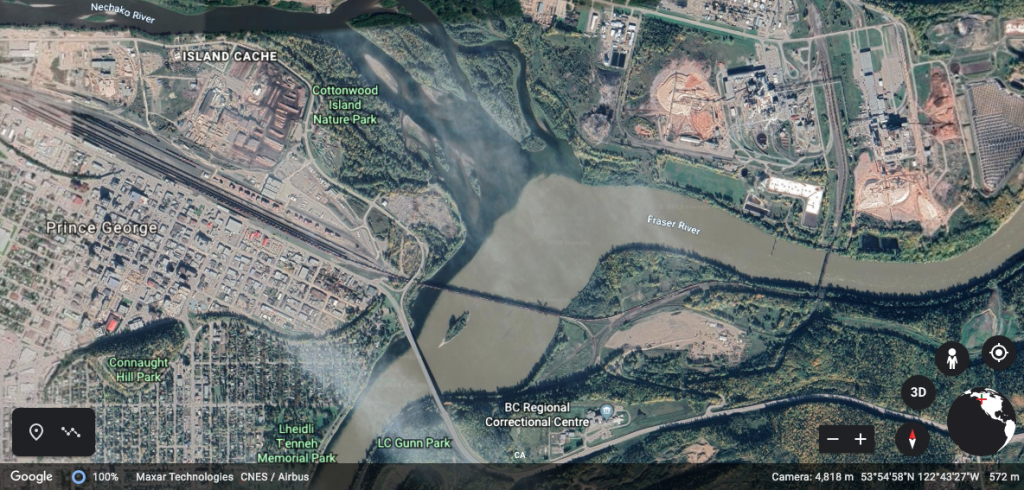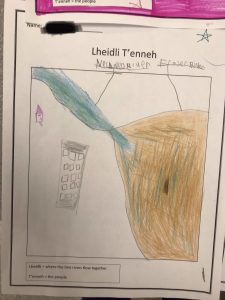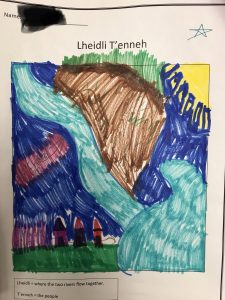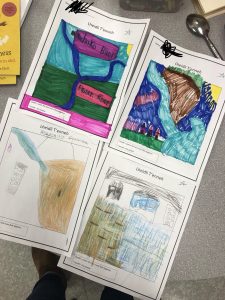For me as an educator it is important to me to include Indigenous content into all aspects of the curriculum. To me the First People’s Principles of Learning are meant to be included holistically into everyday learning in the classroom. I ensure all of my students know about the First People’s Principles while incorporating them into lessons and activities. The following examples are just some of the ways I include Indigenous content as well as Indigenous ways of knowing and being that are the basis for the First People’s Principles into my lessons
Lesson: Understanding the Local Indigenous Community through Language and Exploration
During my practicum I was tasked with teaching a second language lesson for my Grade 1/2 students. Since I am passionate about learning being grounded in the local community I decided to focus on the meaning of Lheidli T’enneh. In Carrier, the local Indigenous language, Lheidli means where the two rivers meet and T’enneh means the people. To introduce this lesson we had a discussion about different languages from around the world. Some students even tried to speak in a language other than English. Students were then introduced to the fact that there are more than 70 First Nations languages across Canada. I read students My Heart Fills With Happiness written by Monique Grey Smith. This book is written in both Plains Cree and English. I explained to students how languages look and sound different and that we have to be respectful when attempting to speak in another language. Students were all given a copy of this book to take home as part of a reading initiative across Canada that provides free books to grade one students.
After reading the book I introduced students to the Lheidli T’enneh. Most students knew who they were but did not know much about them. I explained to students that the traditional language of the Lheidli T’enneh is Carrier and that today we would learn what Lheidli T’enneh means in Carrier. In order to teach the students this lesson I used google earth to show students where exactly the two rivers meet and the site of the former village of the Lheidli T’enneh. I showed students pictures of the former Lheidli village as well as what it looks like now. Students were curious about what happened to the Lheidli T’enneh and wondered why they were forced to move from their village. Students also were very curious about the geography of the Fraser and Nechako Rivers. The student’s questions have greatly informed my practice because they have shown me areas in which students are interested. In social studies we will explore more about the Lheidli T’enneh and their history. In Science there is the option to explore the rivers and water systems around Prince George and how they are vital to our community.

Google Earth rendition of where the Nechako River joins the Fraser River in Prince George. Lheidli T’enneh Memorial park seen on the map in the bottom left, is the former site of the village of the Lheidli T’enneh.
To show their learning from this lesson students had to draw what Lheidli T’enneh means (the people of where the two rivers meet). My only criteria and expectation for this activity was that students included the two rivers meeting. In order to assess student’s understanding I questioned each student about what was in their picture and why. I also asked students if they knew what Lheidli T’enneh means. The conversations with students was amazing as every students learned something from the lesson. Some common things that students explained to me that they learned in this lesson are that the two rivers meet in Prince George, that the Lheidli T’enneh used to live along the Fraser River and other students remembered that Lheidli T’enneh means where the two rivers meet. Below you can find some of the examples from students as well as some of their comments from our conversation.
 This student decided to label the two rivers. This was not part of my criteria but most students ended up labelling the two rivers. I wrote the names of the rivers on the board for students to copy. This particular student took inspiration from the photo of Lheidli T’enneh park today where apartment buildings exist in the background. This student also recalled from personal experience that the Fraser River has brown water in it, hence the water colour of the Fraser.
This student decided to label the two rivers. This was not part of my criteria but most students ended up labelling the two rivers. I wrote the names of the rivers on the board for students to copy. This particular student took inspiration from the photo of Lheidli T’enneh park today where apartment buildings exist in the background. This student also recalled from personal experience that the Fraser River has brown water in it, hence the water colour of the Fraser.
 This student labelled the two rivers and explained to me that she had drawn the village of the Lheidli T’enneh down towards the bottom. This student also recognized the cutbacks in the background of both the past and present picture of Lheidli T’enneh Memorial Park and recognized them from living in Prince George, she therefore decided to include them in her picture.
This student labelled the two rivers and explained to me that she had drawn the village of the Lheidli T’enneh down towards the bottom. This student also recognized the cutbacks in the background of both the past and present picture of Lheidli T’enneh Memorial Park and recognized them from living in Prince George, she therefore decided to include them in her picture.
 This Image Reflects the variety of work that I received. Every picture drawn meets the criteria and each students was able to explain to me one thing that they learned from this lesson.
This Image Reflects the variety of work that I received. Every picture drawn meets the criteria and each students was able to explain to me one thing that they learned from this lesson.